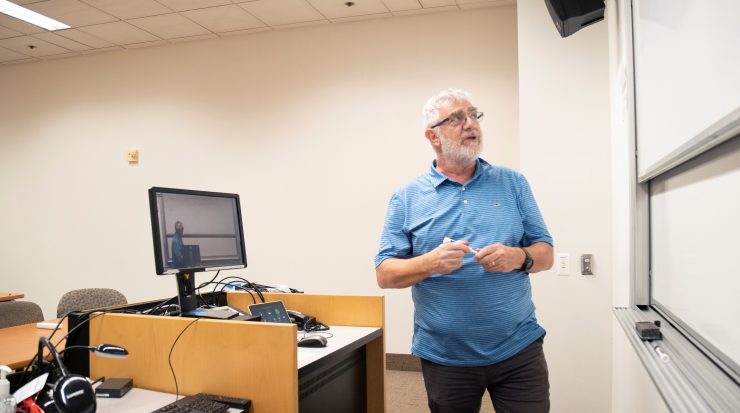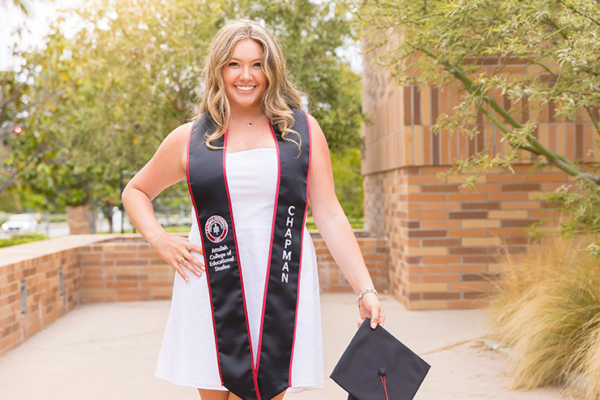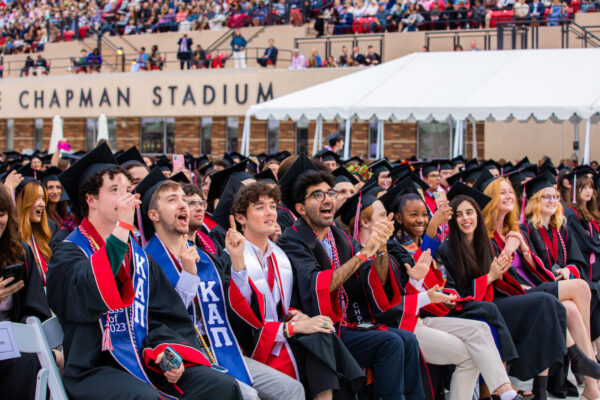A film festival any student can attend from anywhere. Discussion rooms where classmates gather, master quizzes together and share virtual high-fives. Anatomy software that vividly reveals the inner workings of the human body – and lets you return at any time to review before the big test.
Those were just a few of the scenes from Chapman University’s spring and summer instruction, delivered online after the university closed campus in response to the coronavirus.
Faculty and Tutoring Center Prepare
Plenty more moments like those are coming soon, too, as the campus prepares for what will initially be a virtual reopening of campus this fall, to be followed by a mix of in-person, HyFlex and online instruction. Faculty and support staff are working through the summer to learn even more online tools and methods. Workshops, ask-an-expert office hours and equipment investment are just part of the robust effort to prepare faculty for fall. Similar efforts are underway at the Tutoring and Learning Center.
“The challenges of spring pushed people into that space of trying new things. Faculty are working hard. They’re students themselves all over again. And sometimes learning something new is how exciting things happen,” says Jana Remy, co-director of Chapman’s Institute for Excellence in Teaching and Learning.
Call it summer training camp, of a sort. Even Chapman President Daniele Struppa, who teaches a mathematics course each fall, was among the ranks.
Indeed, this fall will be different at Chapman’s Orange and Irvine campuses, but the university’s dedication to excellence is unwavering, says Lawrence “LB” Brown, vice-provost for academic administration.
‘Rigorous and Engaging as Ever’
“Our faculty are working throughout the summer to ensure that their courses and curricula are as rigorous and engaging as ever,” says Brown, who’s also a tenured professor of pharmacoeconomics and health policy. “Today’s circumstances are difficult, but the resilience and dedication of our teachers and technology support staff will provide our students a personalized education and rich learning experience in any format. This semester will look different, but I am confident we will continue to deliver an excellent learning experience and a high quality education for our students.”
Chapman was uniquely equipped to make the shift to online instruction, which will remain an option for students this fall even when health authorities permit face-to-face instruction. Thanks to a forward-thinking investment in technology that began well before the pandemic, as well as fundraising efforts that pivoted to support students during the pandemic, instruction won’t miss a step, says Helen Norris, vice president and chief information officer.
Classrooms Enhanced With New Technology
“Virtually every classroom on both campuses will have technology that allows the class to be broadcast via Zoom to students participating from anywhere in the world, and allows active participation by students in the room and students online simultaneously. It allows for faculty to share content from their computers or from a whiteboard in the classroom, allowing our students to access the rigorous curriculum Chapman provides our students, and allowing them to interact with our great faculty as they would on campus,” Norris says.
Fostering Student Collaboration
For example, special features in the Canvas classroom management system enabled David Richards to maintain classroom comradery the anatomy classes he teaches in Crean College of Health and Behavioral Sciences.
“Students liked being able to work in their small groups just like they did prior to going remote,” Richards says.
A digital cadaver system purchased for Crean offers unique capabilities, too.
“It is something the students love because unlike actual anatomy models, they can access these resources any time and from anywhere,” Richard says.
Similarly, in her leadership courses in Attallah College of Educational Studies, Angel Miles Nash still presented a rigorous program for students who created videos, websites, podcasts and engaging visuals through Adobe Spark. Accomplishing those tasks online extend well beyond the immediate task of learning, Nash says.
“These are skills in technology that they can use in their future jobs, especially with a lot of work being transformed to the virtual setting now,” she says.
Digital Access Expands Diversity
Online platforms also proved fruitful for a year-long series on race launched by Wilkinson College of Arts, Humanities, and Social Sciences. Instead of real-time screenings, students watched at their convenience the films selected for “Engaging the World: Leading the Conversation on the Significance of Race.”
Discussions were rich because students had time to reflect and the wide-open digital doors empowered a more diverse audience to “attend,” says Stephanie Takaragawa, associate dean of academic affairs in Wilkinson.
“It takes a while to really digest a film, so this format is super helpful,” says Takaragawa. “We had experts from the field along with people who were just genuinely curious about the topic join the conversation. It brought together a much larger community.”
“Learning doesn’t just happen in little boxy classrooms anymore.”
Ultimately, such tools and methods will only enhance face-to-face instruction, campus events, field studies, internships and service work when they are safe to resume, Remy says.
After all, says Remy, “Learning doesn’t just happen in little boxy classrooms anymore.”
Learn More
To learn more about ways the university is supporting students and providing resources they need for a meaningful educational experience, visit the CU Safely Back Fund page.




